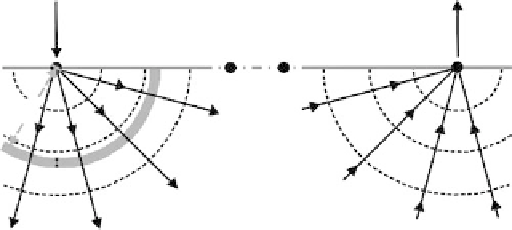Geoscience Reference
In-Depth Information
+I
-I
C
1
P
1
P
2
C
2
r
dr
(a)
(b)
fIGURe 5.3
Electric current flow (solid black arrowhead lines) and electric potential (circular dashed black
lines) due to (a) an isolated electrode,
C
1
, through which current, +
I
, is applied into the ground, and (b) an
isolated electrode,
C
2
, through which current, −
I
, is collected from the ground. The electrode locations for
measurement of potential are
P
1
and
P
2
.
through a single isolated electrode,
C
1
, will spread out in a radial pattern away from
C
1
within the
ground beneath it (again, solid black arrowhead lines), given that the soil or rock material through
which the current travels is homogenous and isotropic. Figure 5.3b shows that for an isolated elec-
trode,
C
2
, that collects current,
−I
, from the ground, there is again a radial pattern of subsurface
current flow, but in a direction toward
C
2
. Regardless of whether electric current is being applied
or collected by an isolated electrode, surfaces of equal electric potential due to a particular current
electrode will have a hemispherical shape centered about the position of that current electrode, rep-
resented two-dimensionally in Figure 5.3 by dashed circular lines.
Consider the gray hemispherical shell with a wall thickness of
dr
that is depicted in Figure 5.3a.
For illustration, the gray hemispherical shell appears thick, but for the sake of discussion, assume
it is infinitesimally thin, so
dr
is actually extremely small. The current application electrode,
C
1
,
is located at the shell's radial center. Let
r
be the radial distance from
C
1
to the inside surface of
the gray hemispherical shell. The area of the shell's inside surface is 2π
r
2
. The resistivity of the
homogeneous and isotropic material making up the subsurface is designated as ρ. The total electric
current flowing across this hemispherical shell equals +
I
, which is the electric current applied at
C
1
.
The electric potential difference from the inside to the outside surfaces of the thin hemispherical
shell is
dV
.
A form of Ohm's law, based on the scenario just described, can be given as follows:
=−
ρ
Idr
r
dV
2
(5.7)
2
π
Upon integration, the electric potential at a distance
r
from
C
1
is expressed as follows:
ρ
I
1
V
r
=+
z
7
(5.8)
2
π
r
where
z
7
= 0
, bec
ause
V
r
= 0 at infinite distance from
C
1
. If
r
is set to equal the distance between
C
1
and
P
1
(
CP
r
=
),
then the potential at
P
1
due to the current applied at
C
1
is:
11
ρ
I
1
V
=
(5.9)
C
11
2
π
CP
11



